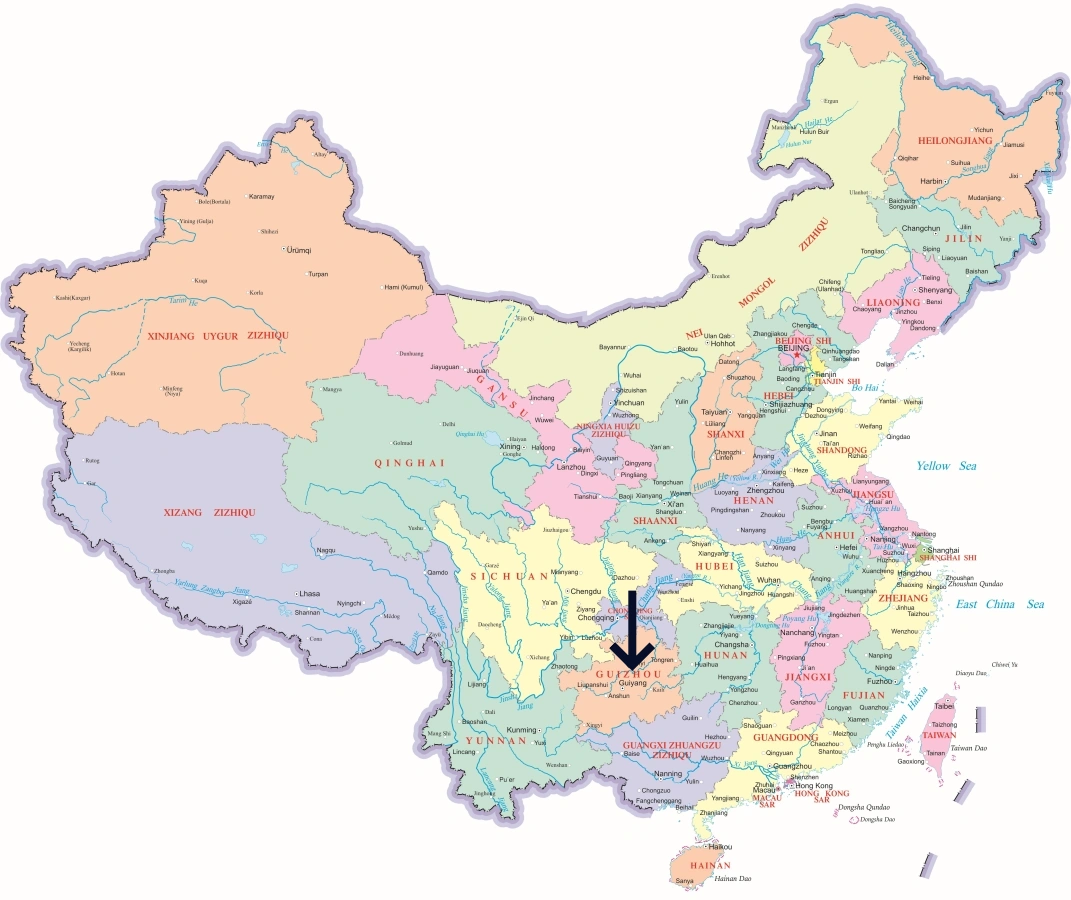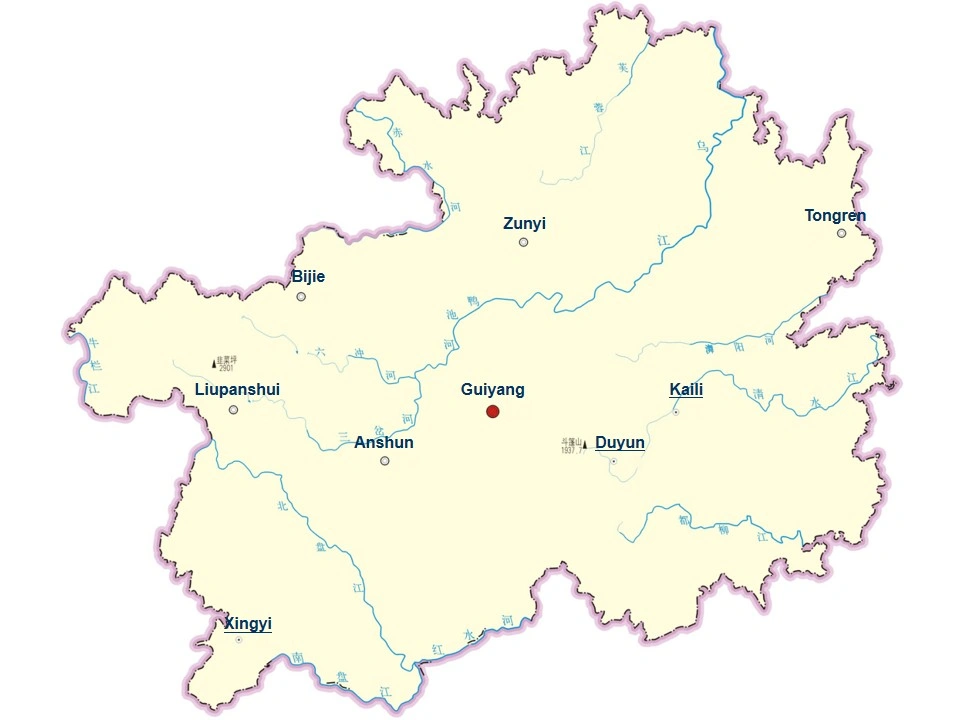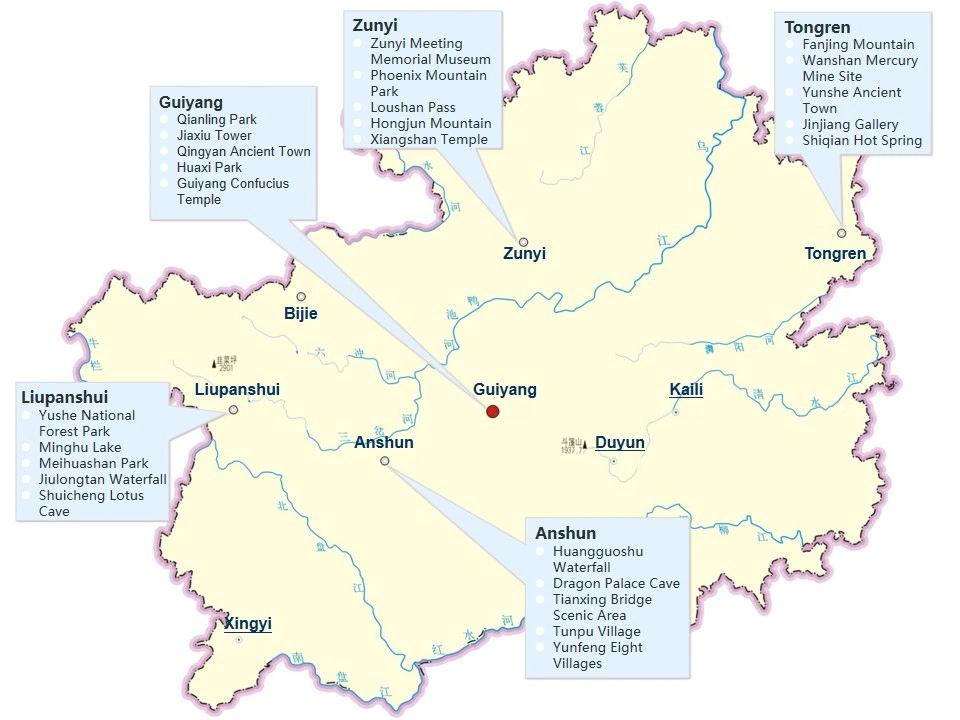Guizhou, often abbreviated as “Qian” or “Gui,” is a southwestern province of China known for its dramatic karst landscapes, rich ethnic culture, and cool year-round climate. Its capital, Guiyang, offers mild weather and a mix of tradition and modern life. As one of China’s most underrated travel destinations, Guizhou blends natural beauty with deep cultural roots.
Unlike the flat terrain of eastern China, Guizhou is a mountainous plateau filled with waterfalls, rivers, caves, and forests. It’s also one of the country’s most culturally diverse areas, home to the Miao, Dong, Buyi, and other ethnic minorities. Whether you’re chasing waterfalls or exploring hidden villages, Guizhou is a dream for adventurous and culturally curious travelers.

Guizhou has 9 administrative divisions, including 6 prefecture-level cities and 3 autonomous prefectures. Each one offers its own flavor of ethnic heritage, natural landscapes, and local experiences.
Whether you’re interested in hiking through remote mountain trails, visiting ancient towns, or learning about traditional crafts, Guizhou’s destinations provide something beyond the typical tourist path. Popular cities include Guiyang, Zunyi, Anshun, and the ethnic regions of Qiandongnan and Qianxinan, while Tongren, Bijie, and Liupanshui are worth a deeper dive for those seeking authentic local life.


As the provincial capital, Guiyang is known as the "Forest City" due to its lush green surroundings. Its mild climate makes it a great place to escape summer heat. Must-see spots include Jiaxiu Tower, Qianling Mountain, and the ancient Qingyan Town.

Famous for the historic Zunyi Conference, this city is a key site in China's revolutionary history. It's also near Chishui, known for its red sandstone landscapes and scenic waterfalls. Don’t miss a visit to the hometown of Moutai, China’s most famous liquor.

Home to the breathtaking Huangguoshu Waterfall and Dragon Palace Cave, Anshun is a hub for nature lovers and cultural explorers alike. You’ll also find ancient villages like Tianlong Tunpu, which preserve centuries-old customs.

Best known for Mount Fanjing, a UNESCO World Heritage site, Tongren is ideal for those drawn to spiritual travel and pristine forests. The surreal mushroom-shaped rock formations and Buddhist temples make it a top nature destination.

Dubbed “China’s Cool City,” Liupanshui boasts comfortable summer weather. The area is full of natural attractions like Yushe National Forest Park and picturesque stone villages.
Guizhou is packed with dramatic landscapes, charming villages, and spiritual landmarks. From towering waterfalls to UNESCO sites, it’s perfect for those who want to experience both nature and culture in one journey.

-300x300.webp)
One of Asia’s largest waterfalls, it thunders over limestone cliffs and creates a misty spectacle. The walkway allows you to view it from multiple angles—including from behind the waterfall itself.
-300x300.webp)
Recognized by UNESCO for its biodiversity, Mount Fanjing is both a sacred Buddhist site and a hiking haven. Highlights include the Red Cloud Golden Summit and the otherworldly Mushroom Stone.
-300x300.webp)
The largest Miao village in China, Xijiang is known for its hillside wooden stilt houses, elaborate silver jewelry, and nightly cultural shows.
-300x300.webp)
Famous for its emerald waters, stone arch bridge, and subtropical forests, this area has earned the nickname “a green pearl on Earth’s waistline.”
-300x300.webp)
This area features striking red cliffs and waterfalls—ideal for nature photography and hiking. The combination of geology and history makes it a compelling stop.
-300x300.webp)
A well-preserved town from the Ming Dynasty with stone-paved streets and courtyard-style homes. Great for trying local snacks and observing Guizhou folk architecture.
Guizhou cuisine, known for its bold sour and spicy flavors, stands out among China’s regional food traditions. Dishes here often use fermented chili sauces and sour broths, making the food tangy and punchy.
Street food culture is thriving in Guizhou’s cities and towns, and local families preserve ethnic cooking styles passed down for generations. If you love bold flavors, this province won’t disappoint.
-300x300.webp)
A hearty noodle soup with pork intestines and blood tofu, this spicy dish is a breakfast favorite for locals and a must-try for adventurous foodies.
-300x300.webp)
Made with fermented rice broth and fresh fish, this hotpot-style dish is flavorful, slightly tangy, and deeply satisfying.
-300x300.webp)
Soft rice noodles paired with slices of beef in a savory broth—simple but rich in taste.
-300x300.webp)
Crispy on the outside and soft inside, these are popular street snacks, often eaten with chili powder and dipping sauces.
-300x300.webp)
A DIY wrap made with thin rice sheets filled with julienned vegetables and topped with sour-and-spicy sauce. It’s fresh, crunchy, and totally addictive.
-300x300.webp)
Local families smoke pork over wood fires, creating a deeply savory flavor. Often served during festivals and family banquets.
Area and Population by City
Note: Population figures are based on recent estimates and may vary slightly.
Monthly Climate Guide (Guiyang as Example)
Best times to visit: April–June and September–November.

 English (US)
English (US)